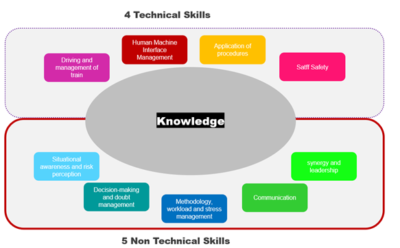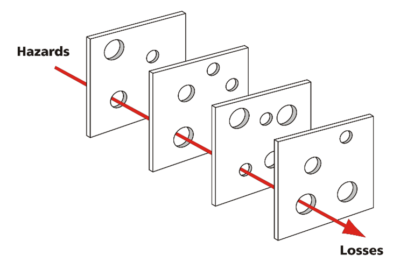What are the key HOF issues? With the influx of HOF specialists in 2008, the Traction Department (SNCF Voyageurs) has undertaken in-depth work to develop the non-technical skills of train drivers. Our work was based on...
HOF models
About this topic
Introduction
HOF models describe theoretical frameworks for the application of HOF. These can range from specific models of particular aspects of human performance, for example signal detection theory models of perception or decision making, to general models of the scope of human factors. The latter type of models are discussed here. General models of human factors are useful to describe the interaction of humans with other parts of a system. Such models can be used to raise awareness of the scope of human factors, and to support human factors analyses which aim to consider different aspects of a system.
Relevance to rail
The rail system is complex with multiple interacting elements coming together to deliver a safe and efficient rail service. Human factors models can help identify which of these elements are relevant to human performance in the railway.
Approaches and models
SHELL Model

The SHELL model was developed by Hawkins in 1975, building on an earlier model, with a focus on the aviation system. It describes the human (referred to as ‘liveware’ in the model) as being at the centre of a system made up of four components:
- Software – software here refers to all non-physical intangible system components, including computer software but also procedures, rules and instructions, norms and conventions, etc.
- Hardware – hardware refers to all the physical elements of a system such as the controls and displays, tools and equipment, buildings, components, etc.
- Environment – environment refers to the physical environment (lighting, noise, weather, etc.) as well as the organisational and cultural environment.
- Liveware – liveware occurs twice in the model; first at the centre representing the person being considered, and second representing all the other people that person interacts with at different levels of the organisation, including co-workers and managers.
In applying the SHELL model, all the interfaces between the liveware (person) at the centre of the model and the other elements of the system should be considered.
UK HSE Model
The UK Health and Safety Executive uses a simpler model which describes HOF as considering three interrelated aspects:
- The job – this includes aspects such as the tasks that must be conducted, the workload imposed on workers, the working environment, and the design and use of equipment
- The individual – this covers aspects such as the competence and skill of an individual and their personality and attitude.
- The organisation – this includes aspects such as the work patterns, culture, leadership and organisational resources.
As with SHELL, the interactions between these three elements should be considered as part of a human factors analysis.
Swiss Cheese Model
The Swiss Cheese Model was developed by Reason to describe how accidents are a result of deficiencies in different layers of defences. The controls against accidents are represented as slices of Swiss Cheese, each with their own weaknesses which are represented as holes in the slices of cheese. Reason argued that accidents occur when a situation arises which exploits the weaknesses in all the individual defences. While primarily a safety management model, the Swiss Cheese model can also be applied as a human factors model with defences including organisational factors such as training, task and environment conditions, and individual or team actions.
5×5 model
The European Union Agency for Rail (ERA) has also developed a more complex 5×5 model to describe HOF.
Reason, 2000. Human error: models and management. British Medical Journal, 320, 768-770
https://www.bmj.com/content/320/7237/768?ath_user=efschouston002&ath_ttok=%3CTPEEDaMygDfSrj8WwQ%3E
Hawkins, 1993. Human factors in flight. England: Avebury Technical.
HSE guidance: Introduction to human factors
https://www.hse.gov.uk/humanfactors/introduction.htm#:~:text=A%20Human%20Factors%20(or%20Ergonomics,better%20managed%2C%20more%20effective%20organisation.

Non-technical skills for the train driver’s job – SNCF Voyageurs
What are the key HOF issues? With the influx of HOF specialists in 2008, the Traction Department (SNCF Voyageurs) has undertaken in-depth work to develop the non-technical skills of train drivers. Our work was based on the scientific definition of...
Reason, 2000. Human error: models and management. British Medical Journal, 320, 768-770
https://www.bmj.com/content/320/7237/768?ath_user=efschouston002&ath_ttok=%3CTPEEDaMygDfSrj8WwQ%3E
Hawkins, 1993. Human factors in flight. England: Avebury Technical.
HSE guidance: Introduction to human factors
https://www.hse.gov.uk/humanfactors/introduction.htm#:~:text=A%20Human%20Factors%20(or%20Ergonomics,better%20managed%2C%20more%20effective%20organisation.

Non-technical skills for the train driver’s job – SNCF Voyageurs
What are the key HOF issues? With the influx of HOF specialists in 2008, the Traction Department (SNCF Voyageurs) has undertaken in-depth work to develop the non-technical skills of train drivers. Our work was based on the scientific definition of...
Reason, 2000. Human error: models and management. British Medical Journal, 320, 768-770
https://www.bmj.com/content/320/7237/768?ath_user=efschouston002&ath_ttok=%3CTPEEDaMygDfSrj8WwQ%3E
Hawkins, 1993. Human factors in flight. England: Avebury Technical.
HSE guidance: Introduction to human factors
https://www.hse.gov.uk/humanfactors/introduction.htm#:~:text=A%20Human%20Factors%20(or%20Ergonomics,better%20managed%2C%20more%20effective%20organisation.
Join us
Are you interested in HOF?
Do you want to learn about Human & Organisational Factors? Safety culture, non-technical skills, health and safety, more?
Join us on this international and diverse network which captures in one place the valuable and enriching information and material, either academic or practical railways-oriented, on the organizational and human factors that you need.
Are you involved in HOF activities?
You want to learn about Human & Organisational Factors? Safety culture, non-technical skills, health and safety, more?
Join us on this international and transversal network which capitalizes the valuable and enriching information and material, either academic nor Railways oriented, on the organizational and human factors that you need.
Are you an HOF expert?
Are you a Rail Human and Organisational factors expert, a Rail Safety expert, a Railway Head of safety, or other? This space is made for you. Here, you have access to confidential information and can even create or participate in a discussion forum to initiate conversations and exchanges with your peers.

